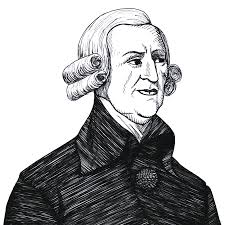Adam Smith, often hailed as the father of modern economics, revolutionized economic thought with his seminal work, “The Wealth of Nations,” published in 1776. Despite the passage of centuries, Smith’s ideas continue to shape economic discourse and policy decisions worldwide. This blog delves into Adam Smith’s enduring legacy in modern economics, exploring his fundamental concepts, their relevance in contemporary economic theory, and their implications for the global economy.
- The Invisible Hand:
At the heart of Adam Smith’s economic philosophy lies the concept of the “invisible hand.” Smith posited that individuals, pursuing their self-interest in a competitive market, unintentionally promote the general welfare of society. The invisible hand mechanism allocates resources efficiently, guides market prices, and coordinates economic activities without central planning. In modern economics, this concept underpins the theory of market efficiency and serves as a cornerstone of free-market capitalism. - Division of Labor:
Smith’s insights into the division of labor underscored its role in enhancing productivity and driving economic growth. By breaking down complex production processes into specialized tasks, firms can achieve economies of scale and efficiency gains. In the contemporary context, globalization and technological advancements have further amplified the importance of the division of labor, leading to the emergence of global value chains and heightened specialization across industries. - Theory of Value:
Smith’s labor theory of value posited that the value of a good or service is determined by the amount of labor required for its production. While this theory has been challenged and refined by subsequent economists, it laid the groundwork for understanding the principles of value creation and exchange in market economies. Modern economists have expanded upon Smith’s framework, incorporating subjective theories of value and considering factors such as consumer preferences and scarcity in determining prices. - Comparative Advantage:
Smith’s concept of comparative advantage elucidated the benefits of international trade based on differences in relative productivity. According to this principle, countries should specialize in producing goods and services in which they have a comparative advantage, and trade with other nations to maximize overall welfare. In today’s interconnected global economy, comparative advantage remains a guiding principle for trade policy, emphasizing the gains from specialization and exchange. - Role of Government:
Contrary to popular misconceptions, Adam Smith did not advocate for a laissez-faire approach devoid of government intervention. While he championed the virtues of free markets, Smith recognized the essential role of the state in providing public goods, enforcing property rights, and mitigating market failures. Modern economists have built upon Smith’s framework to develop theories of market regulation, antitrust policy, and social welfare programs, striking a balance between market efficiency and government intervention. - Wealth and Virtue:
Smith’s conception of wealth extended beyond material prosperity to encompass moral and social well-being. He emphasized the importance of moral virtues such as prudence, justice, and benevolence in fostering a prosperous and harmonious society. In the modern era, economists increasingly recognize the interconnectedness of economic, social, and environmental factors in shaping human welfare, advocating for inclusive growth and sustainable development. - Evolution of Economic Thought:
Adam Smith’s ideas have undergone continual evolution and reinterpretation in response to changing economic realities and intellectual currents. From classical economics to neoclassical economics, Keynesianism, and beyond, successive generations of economists have built upon Smith’s legacy, refining his theories and addressing new challenges such as globalization, technological disruption, and income inequality. Smith’s enduring relevance lies not in dogmatic adherence to his original writings, but in the enduring spirit of inquiry and innovation that characterizes economic discourse.
Conclusion:
Adam Smith’s contributions to economics transcend time and space, offering timeless insights into the workings of markets, the role of government, and the nature of wealth and welfare. His ideas continue to inform economic policy debates and shape the trajectory of global economic development. As we navigate the complexities of the modern world, the enduring legacy of Adam Smith serves as a guiding light, reminding us of the enduring principles of prosperity, freedom, and human flourishing.






